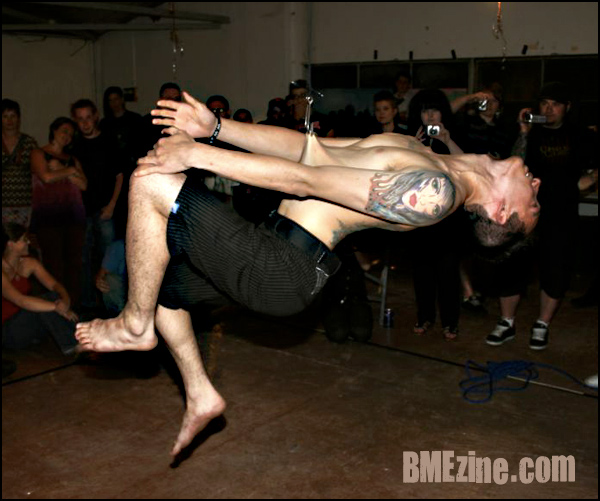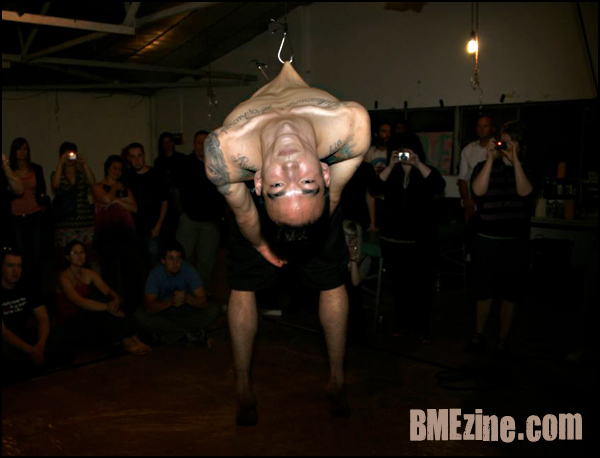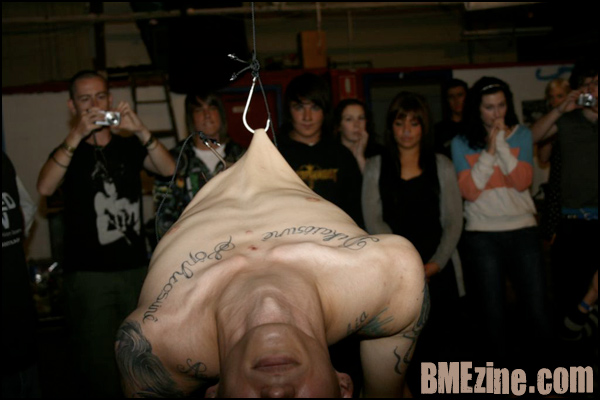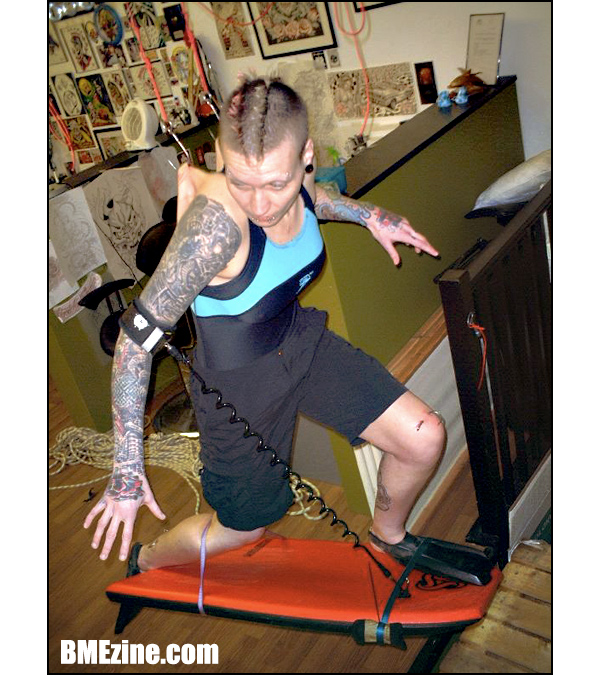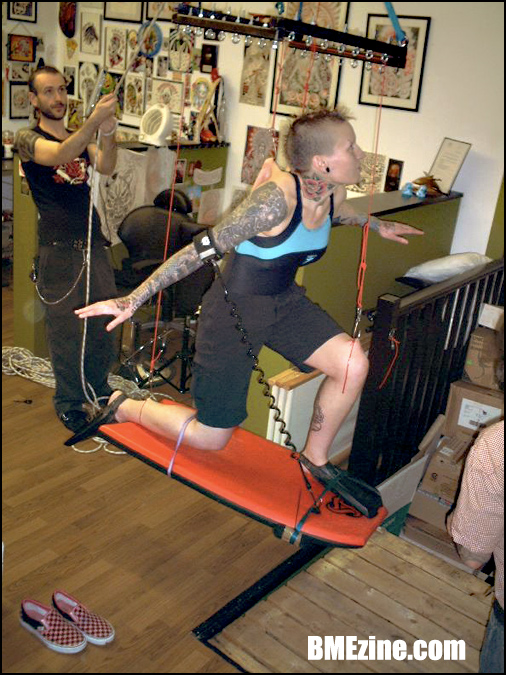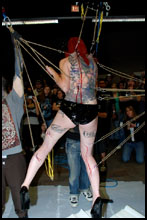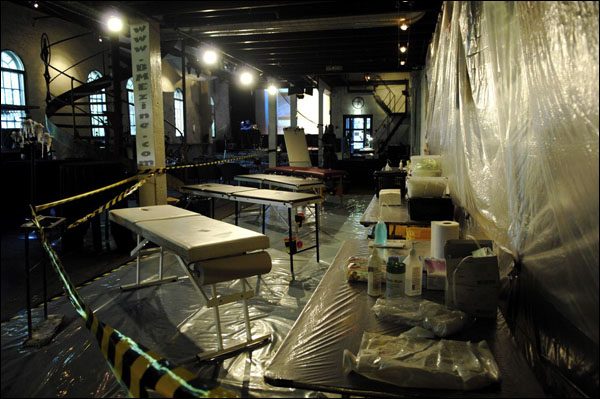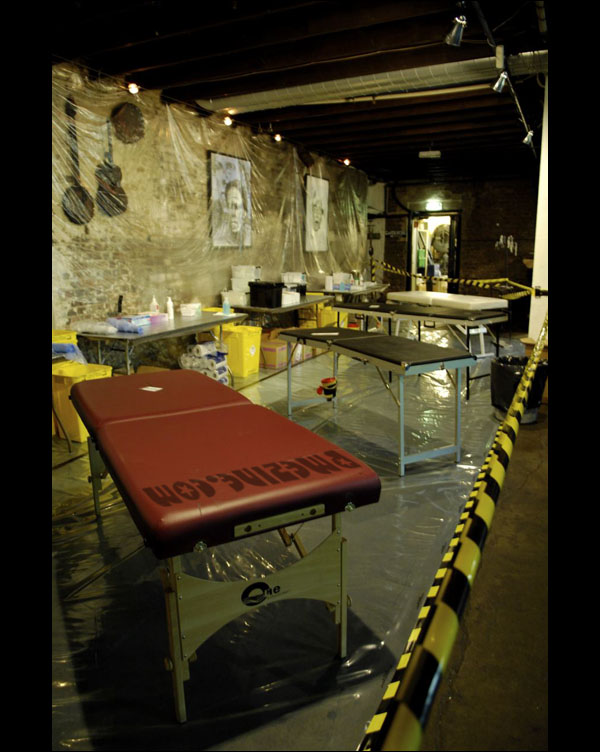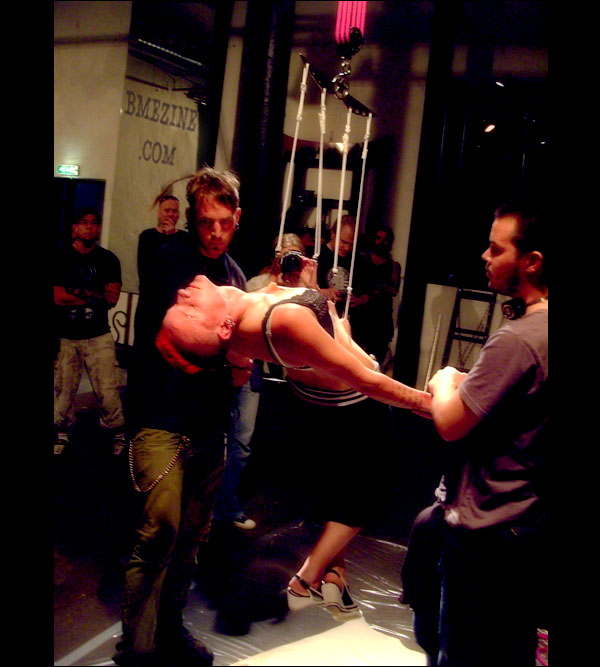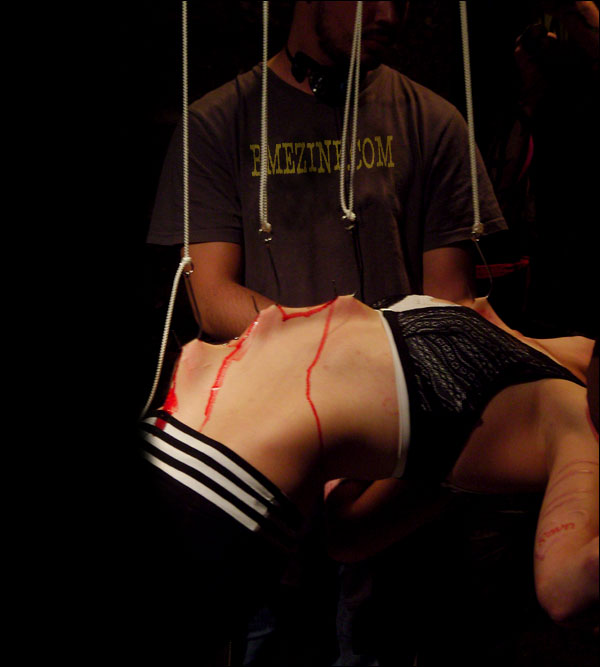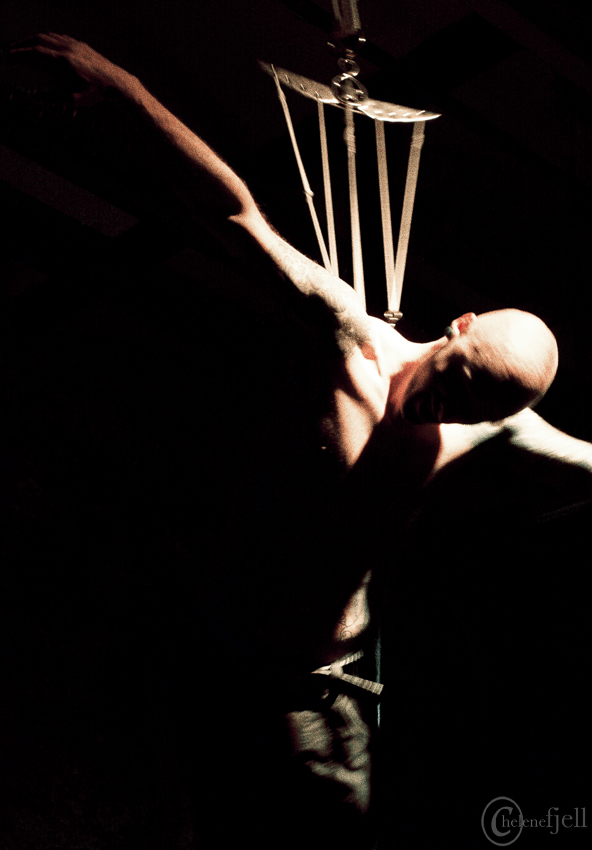OK, some of you may be asking yourselves what the “other” traveling scarification guy is doing speaking up about suspensions and what happened in Florida over the weekend of August 16 and 17, 2008. Now, I’m not just some other modification-basher speaking ill of the whole subject. On the contrary, my immediate suspension family and I have dedicated a large part of our lives to the progression and advancement of the art of body suspensions, and to see something like this happen really makes my stomach drop.
 |
| The original article. |
I am a veteran suspension practitioner with over a decade of practical hands-on suspension knowledge in a variety of settings: private; performance; large scale projects involving great heights with multiple people — including much of the suspension footage you have probably seen on TV on Ripley’s Believe it or Not and the Discovery Channel, to helping hang one Criss Angel from a helicopter; and many private gallery and art shows. But, my main interest has always been in high tension, highly kinetic suspension that culminates with my pride and joy: the 360, though we’ll get to that later. My point is, after a decade of practical, hands-on experience with the subject, I have also recently stepped into the arena of educating newcomers on the subject and art of body suspensions, so I feel well qualified to speak on the topic.
After all this time, blood, sweat and tears my dear suspension family and I have dedicated to furthering this art, one thing we have learned is that accidents do happen. We will be the first to admit that. I have personally witnessed many mishaps occur over the 13 years I have been involved with suspensions. Some could have been avoided, some couldn’t have been — there is no accounting for what should always be the weakest link: the skin. There have even been two cases in which people were injured where I was personally involved and, one time, one of those people was me. It jacked my lower back up in a way that still plagues me today. That definitely changed my mind about things.
Both times something happened during a suspension, not only did we know the negative impact it would have on the community (and did all we could to halt and reverse it), we also did everything we could to inform others about what the problem was and why it happened, in order to try to prevent it from happening to others. Some of our family had already been hurt physically and there was no reason for others to suffer the same fate. We didn’t shy away from the public backlash that was bound to happen. We wanted to try to get others to see how dangerous it can be and that safety is the first thing we should all have on our minds. We, as the suspension leaders at the time, thought of the community and what the impact of our actions would be.
 |
| Rich falls during practice. |
To me, it didn’t seem right to just blame the hardware company when it was our fault if the materials were used inappropriately. Using materials that cause a mechanical failure and injury to a member of your suspension family is not a way to run a suspension group, or a way to look after your friends, in my humble opinion. So, learning from our mistakes, we opted not to — ever again.
We owned up for our oversights. We all got together and wrote up something that illustrated differences in marketing and wording when buying the materials and equipment that will hold human life in the balance. We showed what gear to use, explained ratings and what to look for. We took pictures showing differences and ways to self-test things. We even had it posted to ModBlog as a way to inform others that accidents happen and, hopefully, ways to avoid them. When human life is at stake, leave nothing to chance!
Growing up in the suspension environment that I did with the people with whom I learned, I have always been one for pushing limits and taking suspensions further. I got this crazy idea in my head about a “rotisserie” one night during the now-legendary all-night IHOP TSD meetings, and TSD made it happen. Since that was pulled off without a hitch, I got the idea for the end-over-end version of a rotisserie, or a 360. With the help of Tom Moore, an engineering friend with much more smarts than I, it became a reality. High tension kinetic suspensions were a very new thing back then (and remain so, in my opinion). Not much work has been in done in that area of suspensions, and I think with those sorts of experimental suspension trials, there is more leeway in terms of public acceptance of mishaps when doing something that has never been before. If done in private, that is, and not as part of a show.
The incident I’m speaking of, and which many of you might remember, was during a private suspension group practice while attempting to conquer the now infamous 360 suspension rig during; the other mishap was with a friend, trying out some stuff for an upcoming show. Yes, we try things out before shows to ensure they will work the way we expect them to because, as we all know and as this incident shows, things don’t always happen like you want them to. The way I have always seen it is if you see a suspension group as a band, doesn’t it make sense to try out your sets and get them down before you play them in public? I think TSD, CoRE and MAYHEM were some of the only groups I have ever heard of even attempting to do this. I attribute this to why there has always been a huge difference in stage shows between a real suspension group and people who just hang others.
If things have been done before, there shouldn’t be any oversights other than sheer neglect on the part of the department head that allowed the mishap to occur. If the same sort of neglect happened in a private corporation, I’m sure someone would have to answer for their inadequacies. I don’t see this with the current situation in Florida.
We publicly admitted when Richard fell off the 360, even though we didn’t have to. We explained and showed with pictures why the turn buckle failed, and made it clear that there were oversights on our part. But the fact remains, we admitted it. We knew the eyes of the community were on us as high profile practitioners and the experts in the field — which not only shows it can happen to anyone, but also how such an incident should be dealt with. We knew our responsibility not only to our team member Richard, first and foremost by getting him medical care and taking him to the hospital, but we also knew we had an obligation to explain to the community that we were trying to better our techniques and make progress. We knew we had to put out the equivalent of a press letter showing photos (one advantage of filming your own stunts) of the equipment failing, with diagrams showing what happened and why. We put information out there and accepted responsibility for our actions. This is sorely lacking in the current situation in Florida. We could have kept it quiet, but that wouldn’t have done anyone any good and Richard’s pain and suffering would have been all for nothing if nobody had learned from these mistakes.
 |
| Ron and MAYHEM experimenting with the 360 spin-off. |
I’ve heard suspensions compared to the danger of BMX riding or skateboarding recently. I don’t agree with this at all. The difference is that in those extreme activities, the people are controlling their own bailouts; they haven’t put their lives in someone else’s hands and expecting things to be OK. In that case, you control everything yourself.
I heard it said that Jimmy (the poor fellow to whom this unfortunate incident happened) knew quite well of the possibility of complications with what he was doing. “He knew the risks” has been passed around. I’m sure if this thinly veiled attempt at passing the blame to him was truthful and he was indeed told that the sub-par rigging might break and he could break his legs, he might not have gone for it.
There are a couple of questions that stand out in my mind:
– Why wasn’t there secondary rigging involved, especially when they are expecting extremely intense G-forces to be applied to those links?
– Why were Home Depot links used instead of rescue, safety, or climbing equipment? Those quick links used are not rated for such a working load. This lack of suspension prowess is what caused the mechanical failure over the weekend.
Speaking to Allen Falkner, another notable expert in the field of body suspensions, he had these thoughts on the situation:
Here are the scenarios I can think that might have caused the accident:
– Faulty link (Home Depot is not really known for quality).
– The monofilament line, being so thin, was concentrating the pressure onto a very small point, creating excessive stress. (It makes sense that the thin line was creating a stress point that the links aren’t designed to take.)
– The link turned sideways. If the link was being pulled from a direction other than that for which it’s designed, it could be more prone to failure. Especially if it flipped and the nut was against the hook eye.
Here are the problems I can see:
1. Use of Quick Links: I know we use them often for suspension, but they are designed for static loads, not dynamic. Plus, they are not intended for human weight. Yes, we use them incorrectly in basic suspension situations and although I think they are adequate for static loads, it now seems time to discontinue this practice.
2. Accessory Cord: It is definitely stronger than 550, but not really designed for shock loading. A larger rope or webbing would have been more suitable.
3. Dynamic Rigging: In a fall like that, static rigging would have been the best in case of single hook failure.
4. Hooks: Gilson hooks handle dramatically more weight. Plus, there was definitely a chance of him bouncing off open hooks.
5. Safety Harness: This one is self explanatory.
6. Monofilament Line: I am completely unaware of its properties and how it would affect rigging components.
On the shoulders of giants we stand. Collectively, we set the bar and standards for others to follow and live up to. I don’t see any actions coming from the teams involved with this worth following, or examples showing other fledgling groups how to deal with situations like this. It only has to happen once for anything to get outlawed or shut down. A perfect example of this can be seen by looking at pyrotechnics and the ’80s rock band Great White. They also had careless stage directors and stage managers who didn’t pay attention to stage specs for a safe and proper pyrotechnic show, and the entire auditorium caught fire, trapping and killing many people. This made authorities come down incredibly hard on all who use pyrotechnics here in the USA. This is a precedent that I would hate to see applied to any facets of our industry. All because someone didn’t care enough to pay attention to specs. A scarier thought to me is what if this crew had attempted another feat they were equally unqualified to perform, like a knee-to-back transition? That would be hard for anyone to survive from that height. What would we do then?
The truth is, I’m really scared of the repercussions and backlash that our community will face because of this “passing the buck” attitude I am seeing from the groups involved, with no one accepting responsibility for what happened. To me, responsibility to your friends and group go far deeper than taking them to the hospital and telling everyone to wish them well online. Responsibility means accepting consequences for you actions and attempting to make up for them. I would think they would try to educate and show others how to prevent this from happening again so others don’t get hurt — not shifting the focus to your ailing friend in the hospital, trying to taking the attention off what you caused to happen with your oversights. But I’m old — maybe ethics and morals are a dying personal trait in this industry. (Did I really say that? Me? Moral? Wow, I must be getting old.) But a quick look at the group leader’s MySpace page and following his links to what he finds important to promote about himself, I get a better idea of the ethical morality of this person. I begin understand why they aren’t speaking up about what actually happened, and disseminating rumors about it all so we are forced to make our own assumptions about what truly happened. This is not the way professionals handle things.
For the record, I do not know Skin Mechanic or the guys involved with this. I know they were closely associated with some people making and selling hooks to our community, but I don’t think that endeavor will take off after this latest mishap, especially if it is true that the maker of a locking hook wasn’t using them for such a dynamic suspension. That would also speak volumes about their understanding of the act of body suspension and what happens during a dynamic suspension. It’s obvious some people don’t understand it — hell, I don’t get it all when G-forces come into play with dynamic or static rigging, but we at least overcompensate for that. Here’s something from rock-solid rigger Emrys Yetz, explaining how it works:
First, my thoughts go out to Jimmy Pinango for a quick and healthy recovery from the accident. Hope you’re doing well and are with the ones you love.
The accident that recently happened at the Deerfield Beach Tattoo Convention wasn’t due to equipment failure via manufacturer — it was a result of the equipment being used past its Working Load Limit. In order to understand what I’m going to explain, let’s first define Working Load Limit: “The maximum mass or force with which the product is authorized to support in a particular service.” The industry standard in the United States for chain and/or quick links is a 5 to 1 Design Factor, this meaning you take the Maximum Breaking Strength and divide it by 5 giving you your Working Load Limit. The 3/16” Galvanized Quick Link in question that failed had a Maximum Breaking Strength of 660 pounds, meaning its Working Load Limit is 132lbs (via 660 pounds divided by 5). Jimmy Pinango was suspended from six hooks, meaning six Quick Links with a total Working Load Limit of 792 pounds. Now, had he done a static suspension without any free fall, this would have been adequate, since he weighs 300 pounds.
By adding the bungee, you need to take into account that the static weight of 300 pounds no longer applies, because he is going into a free fall. At this point, you are talking about G-force, or the acceleration imparted by natural gravity. In order to calculate the amount of force applied to the Quick Links, you have to multiply the mass or Jimmy P’s weight of 300 pounds by the G-force or 32.174 feet/per second per second. In doing so, you come up with a Force equal to 1333.7044 newtons, which converts to 983.68988 pounds.
So, let’s look back to the Working Load Limit of 792 pounds that we calculated for the six Quick Links in use before, and we can see there were 983.68988 pounds of force being applied, which surpasses the Working Load Limit overall by 191.68988 pounds and by 31.94831 pounds per Quick Link.
I am speaking as a long-time suspension enthusiast and pioneer who sees this latest act of negligence as a sign of what’s to come, now that Pandora’s Box has been opened and anyone can pick up equipment anywhere. Except, often, they’re only copying what they see without real practical knowledge of research and development done anymore, like we used to do in the “good old days.” Nowadays, it’s all about copying what you see and trying to make a name for yourself with whatever claim to fame you can make — from the most piercings, to the most suspension positions, to eyelid microdermals. Don’t misunderstand me, I have always been one who highly respects outside-the-box thinking (hell, that’s how I got where I am), but these are things I don’t place in that category at all. It is things like this that will lead to the over-regulation of our industry into the ground.
We, the suspension community as whole, got lucky that Jimmy wasn’t injured worse than he was, and our hearts go out to him. But, I don’t think the suspension industry will be able to recover from this very quickly. What I want people to get out of this is, yes, the act of body suspensions has inherent dangers, but we shouldn’t leave anything to chance, especially when lives are at risk. I also wish people would accept responsibility for their actions.
If you don’t know what you’re doing, don’t do it. Don’t put the blame on mechanical failure when it’s your fault the equipment was used in the first place. This sort of thinking neglects to see the big picture: This affects all of us. This should not be done just you so you can get pictures for your portfolio, get your name on TV or to make your sponsors happy.
The words of Social Disortion come to mind:
“Don’t forget that they’re your future …”
And that scares the shit out of me.
(Ed. note: This is an editorial and does not necessarily reflect the views of BME staff or BME as a publication. For Joe Amato’s response, click here.)
Please consider buying a membership to BME so we can continue bringing you articles like this one.

